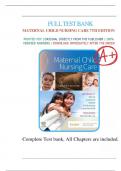, Table of Contents
Table of Contents 1
Chapter 01: 21st Century Maternity Nursing 3
Chapter 02: Community Care: The Family and Culture 17
Chapter 03: Assessment and Health Promotion 27
Chapter 04: Reproductive System Concerns 44
Chapter 05: Infertility, Contraception, and Abortion 65
Chapter 06: Genetics, Conception, and Fetal Development 83
Chapter 07: Anatomy and Physiology of Pregnancy 99
Chapter 08: Nursing Care of the Family During Pregnancy 114
Chapter 09: Maternal and Fetal Nutrition 131
Chapter 10: Assessment of High Risk Pregnancy 148
Chapter 11: High Risk Perinatal Care: Preexisting Conditions 162
Chapter 12: High Risk Perinatal Care: Gestational Conditions 182
Chapter 13: Labor and Birth Processes 204
Chapter 14: Pain Management 217
Chapter 15: Fetal Assessment During Labor 234
Chapter 16: Nursing Care of the Family During Labor and Birth 252
Chapter 17: Labor and Birth Complications 276
Chapter 18: Maternal Physiologic Changes 293
Chapter 19: Nursing Care of the Family During the Postpartum Period 307
Chapter 20: Transition to Parenthood 321
Chapter 21: Postpartum Complications 336
Chapter 22: Physiologic and Behavioral Adaptations of the Newborn 354
Chapter 23: Nursing Care of the Newborn and Family 373
Chapter 24: Newborn Nutrition and Feeding 385
Chapter 25: The High Risk Newborn 402
Chapter 26: 21st Century Pediatric Nursing 426
Chapter 27: Family, Social, Cultural, and Religious Influences on Child Health Promotion
433
Chapter 28: Developmental and Genetic Influences on Child Health Promotion 441
Chapter 29: Communication, History, and Physical Assessment 456
Chapter 30: Pain Assessment and Management in Children 476
Chapter 31: The Infant and Family 487
Chapter 32: The Toddler and Family 509
Chapter 33: The Preschooler and Family 527
Chapter 34: The School-Age Child and Family 541
Chapter 35: The Adolescent and Family 557
Chapter 36: Impact of Chronic Illness, Disability, and End-of-Life Care for the Child and
Family 578
Chapter 37: Impact of Cognitive or Sensory Impairment on the Child and Family 595
Chapter 38: Family-Centered Care of the Child During Illness and Hospitalization 614
Chapter 39: Pediatric Variations of Nursing Interventions 626
Chapter 40: Respiratory Dysfunction 648
Chapter 41: Gastrointestinal Dysfunction 666
Chapter 42: Cardiovascular Dysfunction 688
Chapter 43: Hematologic and Immunologic Dysfunction 713
Chapter 44: Cancer 736
Chapter 45: Genitourinary Dysfunction 758
Chapter 46: Cerebral Dysfunction 774
Chapter 47: Endocrine Dysfunction 795
Chapter 48: Musculoskeletal or Articular Dysfunction 811
,Chapter 49: Neuromuscular or Muscular Dysfunction 827
, Chapter 01: 21st Century Maternity Nursing
y y y y y
MULTIPLE y CHOICE
1. When yproviding ycare yfor ya ypregnant ywoman, ythe ynurse yshould ybe yaware ythat yone yof ythe ymost
yfrequently yreported ymaternal ymedical yrisk yfactors yis:
a. Diabetes y mellitus. c. Chronic yhypertension.
b. Mitral y valve y prolapse y (MVP). d. Anemia.
ANS: y A
The y most y frequently y reported y maternal y medical y risk y factors y are y diabetes y and y hypertension y associated
y with ypregnancy. y Both y of y these y conditions y are y associated y with y maternal y obesity. y There y are y no y studies
y that y indicate yMVP y is y among y the y most y frequently y reported y maternal y risk y factors. y Hypertension
y associated y with y pregnancy, ynot y chronic y hypertension, y is y one y of y the y most y frequently y reported
y maternal y medical y risk y factors. y Although yanemia yis ya yconcern yin ypregnancy, yit yis ynot yone yof ythe ymost
yfrequently yreported ymaternal ymedical yrisk yfactors yin ypregnancy.
PTS: y1 yDIF: yCognitive y Level: y Knowledge y REF: y6
OBJ: yNursing yProcess: yAssessment y MSC: y Client yNeeds: y Physiologic y Integrity
2. To y ensure y optimal y outcomes y for y the y patient, y the y contemporary y maternity y nurse y must y incorporate
y both yteamwork yand ycommunication ywith yclinicians yinto yher ycare ydelivery, yThe ySBAR ytechnique yof
ycommunication yis yan yeasy-to-remember ymechanism yfor ycommunication. yWhich yof ythe yfollowing ycorrectly
ydefines ythis yacronym?
a. Situation, ybaseline y assessment, yresponse
b. Situation, y background, y assessment, y recommendation
c. Subjective y background, y assessment, y recommendation
d. Situation, ybackground, yanticipated yrecommendation
ANS: yB
The ysituation, ybackground, yassessment, yrecommendation y(SBAR) ytechnique yprovides ya yspecific yframework yfor
ycommunication yamong yhealth ycare yproviders. yFailure yto ycommunicate yis yone yof ythe ymajor yreasons yfor yerrors yin
yhealth y care. y The y SBAR y technique y has y the y potential y to y serve y as y a y means y to y reduce y errors.
PTS: y1 yDIF: yCognitive yLevel: yComprehension yREF:
14 yOBJ: yNursing yProcess: yAssessment, yPlanning
y
MSC: yClient yNeeds: ySafe yand y Effective y Care y Environment
3. The yrole y of ythe yprofessional ynurse ycaring y for ychildbearing y families yhas yevolved y to yemphasize:
a. Providing ycare yto ypatients ydirectly yat ythe y bedside.




